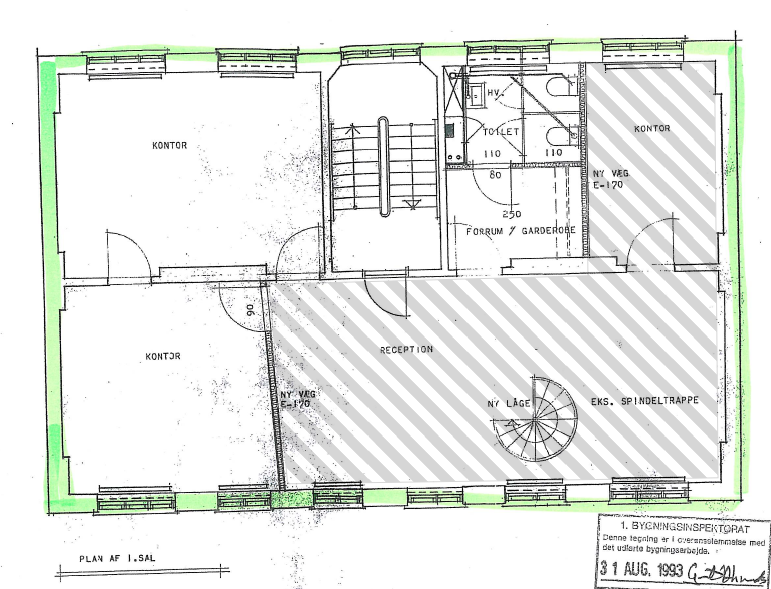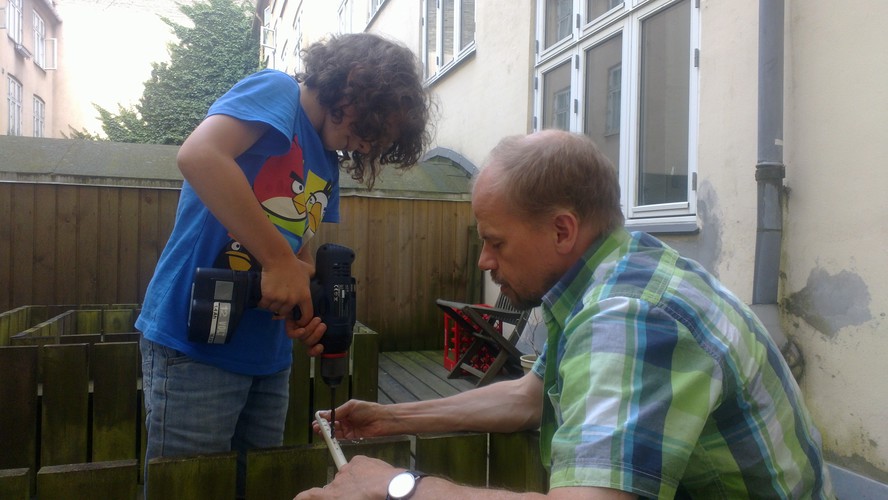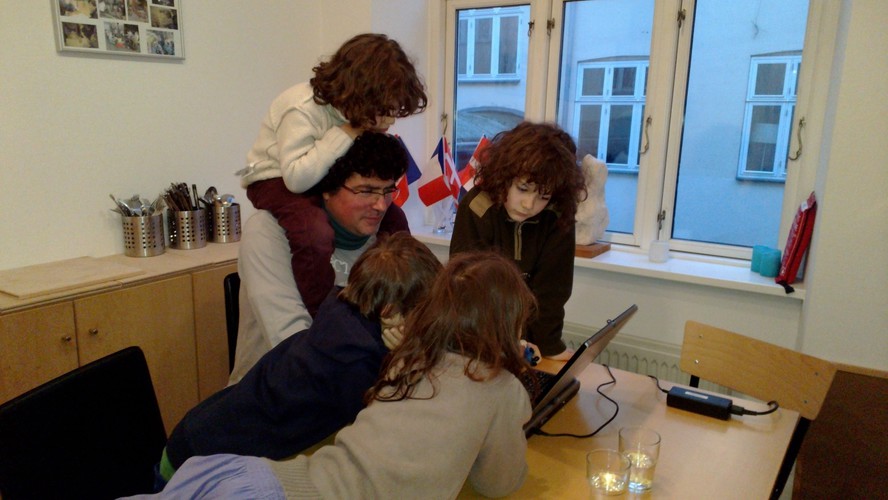“It’s so cozy!”
“Sometimes too noisy”
“Simply life-affirming”
An odd couple
Having a kindergarten and school placed next to a company’s offices is a rare combination. But for the Danish-French School that is how it happened to be, mainly out of coincidence. In 2010, the initial plan of placing the school in one of the developing neighborhoods of Copenhagen turned out to be financially infeasible. We needed to improvise, and ended up borrowing some free office space from the mathematical optimization company Ange Optimization. Ange is specialized in developing math-based decision support software to the industry.

The village
Pure coincidence? No. One of the 3 founding principles of the school is to be participatory, i.e. to encourage the participation of people external to the school. The rationale behind that principle is that the school should be naturally connected to the rest of society in order to ensure that what is taught is relevant and of the highest possible quality.
Ange Optimization had for years had a dedicated playing room for the employees’ children, so for the company, housing the school was mainly an extension of the existing concept.
For the school, the proximity to the company has turned out to be priceless. By having direct access to a team of engineers we have been able to get qualified answers to questions such as “why do airplanes fly?”, got help to build all kinds of things, for instance a ball track and music instruments, got guidance when it came to didactically interesting software tools and more…

Generally speaking, the school is exposed to a plethora of real-world inspired issues. In this way, the teaching, i.e. the “how do we handle these issues?” becomes motivated, and in consequence very motivating.

The proximity of adults also has a more general socializing effect. For instance, the mere proximity of the two groups imposes a certain noise discipline. The adults have to be able to concentrate. But in reality, so do the children. Children want to learn, to improve, to develop. A part of that, an important part, is to be able to concentrate, immerse one self – and that requires calm.
And so it comes all by itself – there is peace and quite at the school. Almost. Most children around here are raised in the somewhat opposite noise culture, and so newcomers often need a few days to adjust to the serenity. Interestingly enough, we have noted that this often is the case for adults as well, as if the general accepted perception of kindergarten/school has become that of a noisy place.
Of course children are children, and we don’t expect them to be calm all the time. That is why we have a separate room where they can simply close the door and be noisy. Also, the afternoon excursion often goes to a large playground, where there are no such restrictions.
The Rules
A fundamental mechanism for structuring the culture of the school is to have clearly formulated rules. The rules delimit what is acceptable and what is not, and are the same for all, children and adults. Ownership of the rules is ensured by each rule being accepted through a plenary vote. Changes to the rules are decided by simple majority, generally around the lunch table. This means that anyone, whether you are 3 or 65, has potential influence – and in consequence feels ownership.
Through this simple model the pupils also get prepared to take responsibility and act in a democratic society, one of the main objectives of the Danish school system.
One important prerequisite for the rules to work is that the adults, who eventually are responsible for the group, constantly ensure that the rules be followed. Children tend to have a very strong sense of justice – it is the adults’ responsibility that it doesn’t get betrayed.
The rules we currently stick to can be found here.
Inclusion
The village has turned out to be very inclusive. Once a week an autistic child participates in the school’s activities. He doesn’t fit in a standard school, but here he is sincerely appreciated by the others in spite of him being different and yes, challenging.
We have tried to include parents in the activities. For ad-hoc interventions, it has been quite successful, but our experience is that a teacher needs to be present to frame the group. We have experimented with having work stations available for parents, who want to spend a day close to the school. The concept did get some initial interest, but has not caught on after that. The parents have until now simply seemed to be too busy, but we still believe that the concept might catch on over time.
We have included trainees in the group, either unemployed persons needing to make an internship as a part of the city’s unemployment program, teacher students and engineering students.
One of the trainees turned out to be a gift. His objective was to boost the programming activities at the school. He didn’t have any particular prerequisites, neither pedagogical nor within programming. What he had was a genuine interest in the childrens’ development and a willingness to leave his comfort zone.
He learned to program Scratch by following some tutorials on the net and subsequently just went in an boosted the Scratch activities at the school. He now benevolently spends a day a week continuing his activities.
What we also learned from that experiment is that having a dedicated person to drive this type of activity appears to be a prerequisite for it to work. It takes quite some effort before the children are autonomous, and during that period the process needs to be fueled.

Involving the engineering students is still very new. The idea is that they get pertinent training by being exposed to real-world engineering issues at Ange, and subsequently acquire understanding by solving them and explaining them for the younger pupils.
A Sound of Nature
Perhaps surprisingly, the collaboration has turned out to be of mutual benefit for the school and the company. When you think of it, a company’s culture is in fact a relatively “narrow” thing. It is very focused on the company’s direction, at solving the tasks at hand. That in itself is fine, it has to be that way for the company to survive in the long run. But hearing the children’s laughter next door naturally gives you the feeling, makes you realize, that you are part of a greater whole. And that is also priceless.
Towards an “Aha! Pedagogy”
Every day, Aha! moments occur in our “village” – the feeling of overcoming something difficult, which then appears as easy – more often than not with the help of others.
In the future we will try to investigate and formalize what it takes to get there. Tentative axes of the investigation will be:
- is a multi-aged environment a prerequisite?
- does the teaching need to be cross-curricular?
- to which extent can we apply Learning by teaching?
- what is the interplay between training, copying and inventing?
- to which extent are long, continuous activity sessions a prerequisite for acquiring complex knowledge and building ownership for the learning?
- why and how do you establish a rule of law? what are the difficulties?
- how can you in a flexible yet systematic way manage and quality ensure the proximal learning zone of each individual?
- can we come up with a framework and/or narratives describing how to systematically involve external resources? what are the benefits of ad-hoc vs. long-term interventions?
- what does it take to recruit, train and retain the appropriate staff?
- to which extent does the concept depend on scale?
- is the collaboration between a school and a company something that could be reproduced?perhaps just in part?